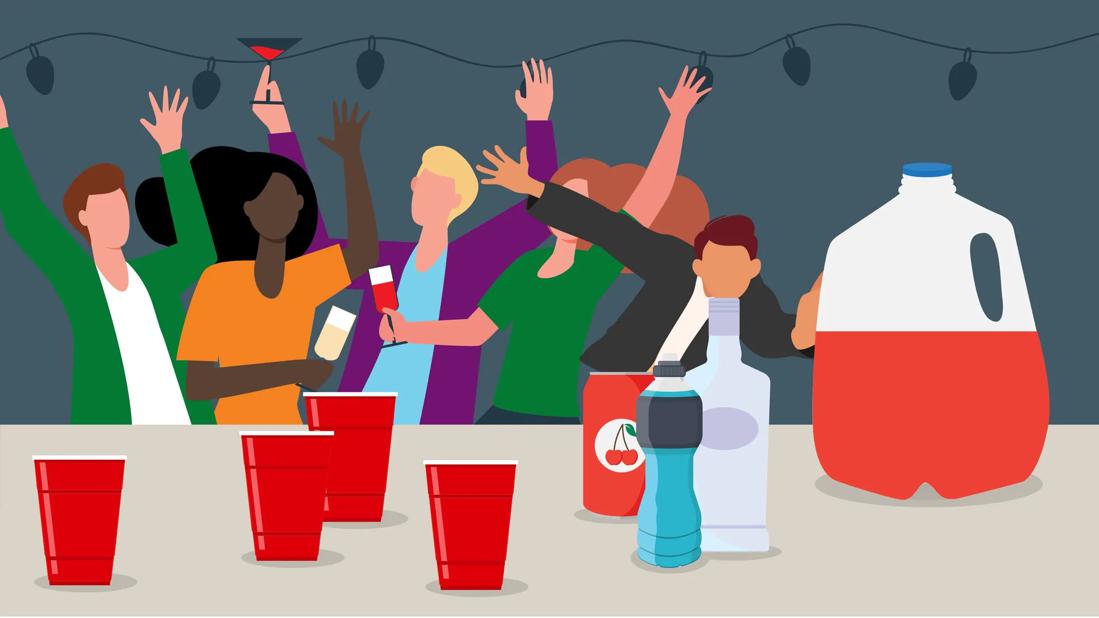‘Blackout rage gallons’ can lead to dangerous levels of alcohol consumption

A BORG is a boozy concoction in a giant plastic jug — and it’s extremely popular among the college crowd. But not just because of the alcohol content: Partygoers actually consider a BORG a safer way to drink. (Spoiler alert: It’s not.)
Advertisement
Cleveland Clinic is a non-profit academic medical center. Advertising on our site helps support our mission. We do not endorse non-Cleveland Clinic products or services. Policy
What is a BORG, exactly? And why is it mistakenly viewed as being a responsible way to drink? Psychiatrist and addiction specialist David Streem, MD, explains the concerning trend.
Let’s start by explaining the funky name. BORG is actually shorthand for “blackout rage gallon,” which accurately describes the potential outcome after someone downs one of these massive drinks.
The potency of a BORG is easy to see if you glance at the ingredients list. To make a BORG, you start with a partially filled gallon jug of water. Then you fill it back up using:
The result is usually a colorful liquid visible through the clear plastic jug. As a final touch, it’s common to assign a BORG a punny name and write it on the jug in black marker. (BORGan donor or BORGinator, for instance.)
The sweet taste of a BORG often masks the dangerously high amount of alcohol in the drink.
“The strategy behind BORGs is to mitigate negative physical feelings associated with drinking more than you could otherwise tolerate,” explains Dr. Streem. “Fundamentally, that’s an unsafe behavior, partly because it fools you into thinking you’re drinking less than you really are.”
Advertisement
The obvious reason behind making a BORG is to get drunk, as college students sometimes do. But some of the rationale behind BORGs is rooted in the idea of safely drinking copious amounts of alcohol.
The TikTok-fueled logic behind BORGs isn’t exactly flawless, as we’ll explain, but here it is:
Now, mixing up drinks is certainly nothing new on campus. It’s often part of college culture. There’s a long and storied history of undergrads combining cheap booze with … well, anything that’s handy.
“The name BORG may be new,” notes Dr. Streem, “but the behavior is just garden variety binging.”
A BORG may be mostly water, but that doesn’t just erase the alcohol that’s in the jug. Remember that fifth of alcohol that got dumped in? That’s the equivalent of almost 17 shots of liquor.
Even diluted, that’s a dangerous amount of alcohol for one person to down during a bout of drinking. The fruity and caffeinated additions to a BORG often mask the taste and effects of alcohol, too, a doubly dangerous combo.
“You have to focus on how many grams of alcohol you’re actually consuming,” explains Dr. Streem. “If you drink the entire gallon jug, you’re drinking the entire amount of alcohol you poured into it.”
Given that your liver can only process about 1 ounce of alcohol per hour, it simply can’t keep up with the high-proof booze spilling out of a BORG. The resulting backup floods your bloodstream with alcohol and can lead to alcohol poisoning.
High blood alcohol levels can be life-threatening and bring symptoms like:
In 2023, an off-campus BORG bash at the University of Massachusetts Amherst left 46 students hospitalized with alcohol poisoning. Thankfully, all recovered after treatment.
Advertisement
The incident underscores how dicey BORG drinking can be, emphasizes Dr. Streem.
The safest choice, of course, is not to chug alcohol or binge drink. There is no “safe amount” of alcohol when it comes to your health, according to the World Health Organization. The risks of imbibing seem pretty clear at this point.
More and more people — and young adults, in particular — are choosing to go dry and avoid all alcohol, too. That’s a positive trend that started two decades ago.
But alcohol isn’t exactly gone from college life or the world in general. Clearly, folks still drink. So, if you’re going to tip back a BORG (or any other libation), keep these tips in mind:
Advertisement
“Lots of young people are learning that they just feel better and accomplish more when they minimize their drinking,” shares Dr. Streem. “And if you have a family history of addiction problems, consider not drinking at all. Genetics is a major factor in addiction risk.”
Advertisement
Learn more about our editorial process.
Advertisement

Your tolerance decreases with age, thanks to body changes, health conditions and medications you may take

An enzyme deficiency or rosacea are potential causes of alcohol flush

ACV may help lower blood sugar and calm acid reflux, but don’t believe all the hype

Yes, grabbing a few beers or a couple of glasses of wine or cocktails with friends can increase your heart rate — dangerously in some cases

Alcohol (in any amount) is a well-known cause of cancer

Forget the myth and answer nature’s call when your bladder feels full

Alcohol provides empty calories, heightens cravings and may slow down your metabolism

Drinking during the day can result in drinking more than usual and worsen your sleep cycle

The best parenting style balances enforcing rules and showing plenty of love

Tips include cutting back on sugar, focusing on exercise and managing stress

It can be harder to let go when you’ve invested time, energy and emotions — but it might be the healthier choice long term